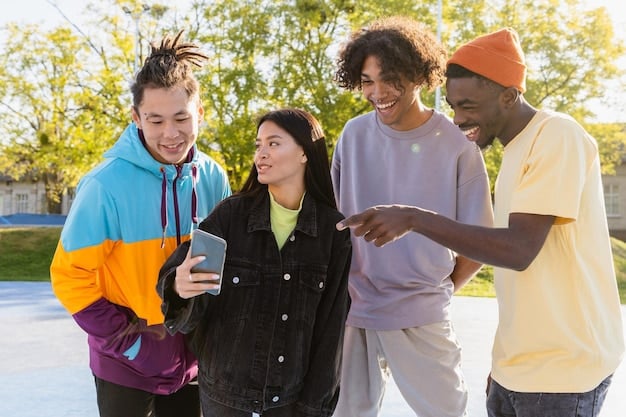Social Media & Teen Mental Health: A Parent’s 2025 Guide

Navigating the digital landscape requires parents to understand the multifaceted impact of social media on teen mental health, offering a critical guide for fostering well-being in 2025.
The digital age has undeniably reshaped the landscape of adolescence, presenting both unprecedented opportunities and complex challenges. For parents, understanding the intricate relationship between social media use and teen mental health is paramount. This guide, tailored for 2025, aims to equip caregivers with insights and strategies to navigate this evolving terrain, ensuring their children thrive in an increasingly connected world.
The evolving digital landscape for teens
The turn of the decade has brought significant shifts in how teenagers interact with social media. What began as a recreational tool has matured into a complex ecosystem influencing everything from identity formation to social connection. In 2025, platfor
The pervasive nature of social media means teens often spend considerable time online, blurring the lines between their digital and physical realities. This constant connectivity can lead to a heightened sense of pressure, as virtual interactions now carry significant weight in their social hierarchies and self-perception. Unlike previous generations, today’s teens are growing up under the unfiltered gaze of public scrutiny, amplified by the reach of social platforms.
The pervasive nature of current platforms
Social media platforms in 2025 are designed to be addictive, utilizing sophisticated algorithms that learn user preferences and display content to maximize engagement. This constant feedback loop can create an irresistible pull for teenagers, whose developing brains are particularly susceptible to instant gratification and social validation. The dopamine rush associated with likes and comments can paradoxically lead to a dependency, where self-worth becomes linked to online metrics.
- Algorithm-driven feeds: Content is highly personalized, leading to echo chambers and potentially exposing teens to harmful or unrealistic ideals.
- Infinite scroll design: Designed to keep users engaged for extended periods, making it difficult for teens to disengage.
- Gamified interactions: Likes, shares, and streaks create a competitive environment that can fuel anxiety and comparison.
- Integrated real-time experiences: Live streaming and ephemeral content intensify the pressure to be constantly available and performing.
As parents, recognizing these design elements is the first step toward understanding why disengagement can be so challenging for teens. It’s not merely a lack of willpower, but a deeply ingrained digital habit reinforced by powerful psychological principles. The ubiquity of smartphones further compounds this, ensuring social media is always just a tap away, day or night.
Recognizing the signs of distress: what to look for
Identifying the impact of social media on a teenager’s mental health can be challenging, as the symptoms often mirror general adolescent struggles. However, a keen eye for changes in behavior, mood, and habits can provide crucial clues. It’s important to remember that not all social media use is harmful; the key lies in observing how it influences a teen’s overall well-being. Look for patterns and correlations between increased screen time or specific online interactions and a decline in mental state.
One common indicator is a change in sleep patterns. Teens might be staying up late to scroll through feeds or respond to messages, impacting their sleep quality and academic performance. Another red flag is social withdrawal from offline activities – opting to spend leisure time online rather than with friends or engaging in hobbies they once enjoyed. Pay attention to their online persona versus their real-life demeanor; a stark contrast could signal underlying issues.
Common behavioral changes
Behavioral changes are often the most observable signs of distress. These can range from subtle shifts to more pronounced alterations in a teen’s daily routine. An increased irritability or defensiveness when discussing screen time is a common warning sign. Similarly, a noticeable drop in academic performance, disinterest in school, or complaints of constant fatigue can be linked to excessive digital engagement.
- Increased mood swings: Unexplained fluctuations between happiness, sadness, and anger, often exacerbated after social media use.
- Social isolation: Withdrawing from family and real-life friends, preferring online interactions.
- Secretive behavior: Hiding phone use, or becoming defensive when asked about online activities.
- Changes in eating habits: Either overeating or undereating, potentially linked to body image issues amplified by social media.
Emotional and psychological indicators
Beyond outward behavior, emotional and psychological shifts offer deeper insights. Teens might express feelings of inadequacy, hopelessness, or heightened anxiety. They may compare themselves unfavorably to peers presented online, leading to lower self-esteem or symptoms of depression. The constant pressure to present a perfect online image can also contribute to perfectionism and self-criticism, as minor perceived flaws are magnified.
It is crucial to differentiate between typical teenage angst and persistent, debilitating emotional distress. If these emotional indicators become chronic and interfere with daily functioning, it signals a deeper problem that warrants attention. Open communication and a non-judgmental approach are vital when addressing these delicate emotional states, as teens may be hesitant to share their vulnerabilities.
The direct impacts: anxiety, depression, and body image
Social media’s influence on mental health often manifests in specific, well-documented ways. Anxiety, depression, and body image issues are among the most frequently cited concerns. These are not isolated problems but often interlinked, creating a cycle of negative reinforcement for vulnerable teenagers. The constant exposure to idealized lifestyles, curated appearances, and social comparisons can chip away at a teen’s sense of self-worth and contentment.
For instance, the fear of missing out (FOMO) is a common anxiety trigger. Seeing friends participate in enjoyable activities without them can lead to feelings of exclusion and inadequacy. This constant awareness of others’ seemingly perfect lives can also fuel depressive symptoms, as teens might internalize the belief that their own lives are less exciting or meaningful. The visual nature of many platforms also puts immense pressure on physical appearance.
Anxiety and FOMO
Anxiety related to social media is often characterized by a heightened state of worry or unease about online interactions or perceived social obligations. The fear of missing out, or FOMO, drives a compulsion to constantly check feeds, ensuring they are not excluded from social circles or trends. This constant vigilance can lead to sleep deprivation, difficulty concentrating, and a perpetual state of stress.
The pressure to respond immediately, maintain streaks, and curate a perfect online persona adds layers of performance anxiety. Teens may develop social anxiety even in real-life settings, preferring the controlled environment of online communication over face-to-face interactions where they feel less in control of their image. The virtual validation they receive can become a substitute for genuine connection, leading to an increasing reliance on digital interactions to fulfill social needs.
Depression and social comparison
Social media can be a breeding ground for depressive symptoms due to the constant exposure to curated, often unrealistic, portrayals of others’ lives. Teens might feel pressure to keep up with their peers, showcasing only their best moments while internalizing the perceived perfection of others. This “highlight reel” effect can lead to feelings of inadequacy, self-doubt, and a belief that their own lives are lacking, fueling a sense of hopelessness.
Cyberbullying is another significant contributor to depression. The anonymity and distance offered by online platforms can embolden aggressors, leading to persistent torment that is difficult to escape. Unlike traditional bullying, cyberbullying can follow a teen home, making it omnipresent and profoundly damaging to their self-esteem and mental well-being. Even subtle forms of social exclusion online, such as being unfriended or left out of group chats, can have a profound emotional impact.
Body image and unrealistic ideals
The visual nature of platforms like Instagram and TikTok places immense pressure on teenagers to conform to often unattainable beauty standards. Filters, editing tools, and influencer culture promote idealized, often Photoshopped, appearances, leading teens to compare their natural selves to these manufactured images. This constant exposure can contribute to body dissatisfaction, disordered eating behaviors, and a distorted self-perception.
The pursuit of the “perfect selfie” or body can consume a significant amount of a teen’s emotional and mental energy, detracting from healthier pursuits. Furthermore, exposure to content promoting extreme diets, excessive exercise, or cosmetic procedures can normalize unhealthy body ideals. Parents must actively counter these narratives, emphasizing self-acceptance and the diversity of beauty, reinforcing that online images are often not true reflections of reality.
Cyberbullying and online harassment: a constant threat
Perhaps one of the most insidious threats in the digital realm is cyberbullying and online harassment. Unlike traditional bullying, cyberbullying can be relentless, reaching teens at any time, anywhere, through their devices. The perceived anonymity of the internet can embolden aggressors, leading to more aggressive or cruel behavior than might occur in face-to-face interactions. This constant threat can have devastating effects on a teen’s mental well-being, leading to a profound sense of helplessness and isolation.
The digital nature of cyberbullying also means that evidence can be easily captured, but also that defamatory content can spread rapidly and persist indefinitely. This permanence can make it incredibly difficult for victims to escape the torment, as the content can resurface even after it has been deleted from original platforms. Parents need to be acutely aware of the various forms cyberbullying can take and how to address them effectively in a supportive manner.
Forms of cyberbullying
Cyberbullying isn’t limited to direct insults; it encompasses a wide array of online aggressive behaviors. Understanding these different manifestations is critical for parents to effectively recognize and respond to incidents. It can range from subtle exclusion to overt threats, each leaving its own unique emotional scar on the victim. The anonymity and speed of online communication amplify the impact, making it difficult for teens to escape the abuse.
- Harassment: Repeatedly sending offensive, rude, and insulting messages.
- Doxing: Sharing private personal information about someone without their consent.
- Sextortion: Threatening to share intimate images unless certain demands are met.
- Impersonation: Creating fake profiles or accounts to pose as someone else and damage their reputation.
- Exclusion: Intentionally leaving someone out of an online group or conversation.
Strategies for parents to combat cyberbullying
Combating cyberbullying requires a multi-pronged approach that combines proactive prevention with responsive intervention. Parents need to establish an environment where teens feel safe to report incidents without fear of judgment or having their devices confiscated. Open communication is key, as is equipping teens with strategies to handle online negativity and seek support.
It’s crucial for parents to document any evidence of cyberbullying, including screenshots and timestamps, as this information can be vital if legal action becomes necessary or if school authorities need to intervene. Reporting the behavior to the platform or service provider is also an important step. Furthermore, teaching teens about digital citizenship, online etiquette, and the importance of empathy can help prevent them from becoming perpetrators themselves.
Fostering healthy digital habits and resilience
While the challenges of social media are significant, it’s equally important to equip teenagers with the tools to navigate the digital world safely and healthily. This isn’t about outright banning social media, which is often unrealistic in today’s interconnected society, but rather about fostering resilience and promoting balanced digital habits. The goal is to empower teens to be mindful consumers and creators of online content, understanding its potential pitfalls and harnessing its positive aspects.
Building resilience in the digital age involves teaching critical thinking skills, helping teens differentiate between authentic and fabricated content, and encouraging them to seek validation from internal sources rather than external likes. It also means establishing clear boundaries and expectations around screen time, content consumption, and online interactions. Parents play a vital role in modeling healthy digital behavior, as children often emulate what they see at home.
Setting boundaries and screen time limits
Establishing clear and consistent boundaries around social media use is fundamental. This might involve creating a family media plan, setting specific “no-phone” zones (like bedrooms or dinner tables), and agreeing on daily screen time limits. Crucially, these boundaries should be discussed collaboratively with your teen, rather than imposed unilaterally, to foster a sense of ownership and adherence.
The quality of screen time is often more important than the quantity. Encourage activities that promote creativity, learning, or genuine connection, rather than passive scrolling. Apps that track screen time can be helpful tools, but ultimately, it comes down to open communication and a shared understanding of why these limits are necessary for well-being. Reinforce that these rules are about supporting their mental health, not about control.
Promoting media literacy and critical thinking
In an age of misinformation and curated realities, media literacy is a vital skill for teenagers. Encourage them to question what they see online: Who created this content? What is their agenda? Is this image real or altered? Teaching them to identify sponsored content, clickbait, and emotionally manipulative posts empowers them to be discerning consumers rather than passive recipients.
Engage in discussions about the curated nature of online life. Help them understand that people typically only share their highlights, not their struggles, and that comparing their everyday lives to someone else’s highlight reel is an unfair and unhealthy practice. Critical thinking extends to evaluating the credibility of sources and understanding the permanence of their own digital footprint, fostering responsible online behavior.
Encouraging offline activities and real-life connections
Balancing online engagement with robust offline activities is crucial for holistic development. Encourage your teen to pursue hobbies, sports, arts, or volunteer work that gets them away from screens and into the real world. These activities provide opportunities for genuine connection, skill development, and a sense of accomplishment that is not tied to online validation.
Foster real-life social interactions by encouraging meet-ups with friends, family dinners, and community involvement. These interactions build essential social skills, empathy, and provide authentic support systems. Emphasize the value of face-to-face communication, where non-verbal cues and nuanced emotions play a vital role, skills that online interactions often fail to cultivate fully.
When to seek professional help
While parental guidance and proactive strategies are invaluable, there are instances where the impact of social media on a teen’s mental health warrants professional intervention. Recognizing these tipping points is crucial for ensuring your child receives the support they need. It’s not a sign of failure but a responsible step towards safeguarding their well-being. A mental health professional, such as a therapist or counselor, can provide specialized strategies, coping mechanisms, and, if necessary, medication.
Trust your instincts as a parent. If you notice persistent and severe changes in mood or behavior, or if your teen’s distress significantly interferes with their daily functioning—academics, relationships, or personal hygiene—it’s time to consider professional help. Early intervention can prevent minor issues from escalating into more serious conditions, providing your teen with a solid foundation for future mental health.
Persistent and severe symptoms
If a teenager exhibits symptoms of anxiety, depression, or other mental health conditions that are severe, consistent, and do not improve despite your best efforts, professional assessment is recommended. This includes prolonged sadness, withdrawal from all activities (online and offline), significant changes in appetite or sleep, persistent irritability, or expressions of hopelessness.
Consider seeking help if:
- Symptoms last for more than a few weeks: Casual moodiness is normal, but prolonged sadness or anxiety is not.
- Daily functioning is significantly impaired: Struggles with school, friends, or family become severe.
- Self-harm ideation: Any mention or sign of self-harm or suicidal thoughts requires immediate attention.
- Increased conflict: Unmanageable anger, defiance, or irritability that disrupts family life.
When social media addiction is suspected
While not formally recognized as a clinical addiction in the same vein as substance use, problematic social media use can exhibit addictive behaviors. If your teen shows signs of compulsive checking, withdrawal symptoms when unable to access platforms, or a significant neglect of responsibilities due to social media, professional evaluation is warranted.
A therapist specializing in adolescent mental health can assess the severity of the issue and develop tailored interventions. This might involve cognitive-behavioral therapy (CBT) to alter thought patterns, family therapy to improve communication, or other therapeutic approaches designed to foster healthier coping mechanisms and digital habits. Remember, professional help is a powerful resource in supporting your child through these challenging times.
| Key Aspect | Brief Description |
|---|---|
| 📱 Digital Landscape | Social media is deeply integrated into teen life, influencing identity and connection through advanced algorithms. |
| ⚠️ Distress Signs | Look for changes in sleep, social withdrawal, irritability, or mood swings related to online use. |
| 😥 Direct Impacts | Anxiety (FOMO), depression (social comparison), and body image issues are common consequences. |
| 🛠️ Healthy Habits | Implement screen time limits, promote media literacy, and encourage offline activities. |

Frequently asked questions about teen social media and mental health
Social media can disrupt sleep through late-night scrolling that delays bedtime, exposure to blue light from screens suppressing melatonin production, and the constant digital stimulation keeping their brains active. This leads to inadequate sleep, affecting mood, concentration, and overall mental resilience.
Beyond explicit cyberbullying, invisible harms include constant social comparison leading to low self-esteem, the pressure to maintain a perfect online persona, fear of missing out (FOMO) causing anxiety, and exposure to idealized lifestyles that foster feelings of inadequacy, subtly eroding mental well-being over time.
Approach the conversation with curiosity and empathy, not judgment. Start by expressing concern, sharing observations, and asking open-ended questions about their experiences. Focus on collaboration to find solutions, emphasizing their well-being, and share your own digital challenges to build rapport and trust.
Yes, social media can foster positive connections with like-minded peers, provide access to diverse perspectives, facilitate learning and skill development, and offer platforms for creative self-expression. It can also be a source of support for teens with niche interests or those facing unique challenges, creating communities where they feel understood.
Confiscation should be a last resort and part of a pre-established consequence for rule violations, not a punitive measure for mental health struggles. If their phone use directly endangers them, consistently breaks agreed-upon rules, or significantly impairs their daily life, consider temporary removal, but always pair it with open dialogue and support.
Conclusion: Empowering positive digital futures
Navigating the complex interplay between social media and teen mental health in 2025 demands a proactive, informed, and empathetic approach from parents. It’s an ongoing journey of observation, education, and adaptability, not a one-time fix. By understanding the evolving digital landscape, recognizing the signs of distress, and implementing healthy digital habits, parents can significantly mitigate the risks and maximize the benefits of online engagement. The ultimate goal is to equip teenagers with the resilience and critical thinking skills necessary to thrive in an increasingly connected world, fostering a generation that is digitally savvy, emotionally intelligent, and mentally robust. Your active involvement is their best shield and greatest advantage.






